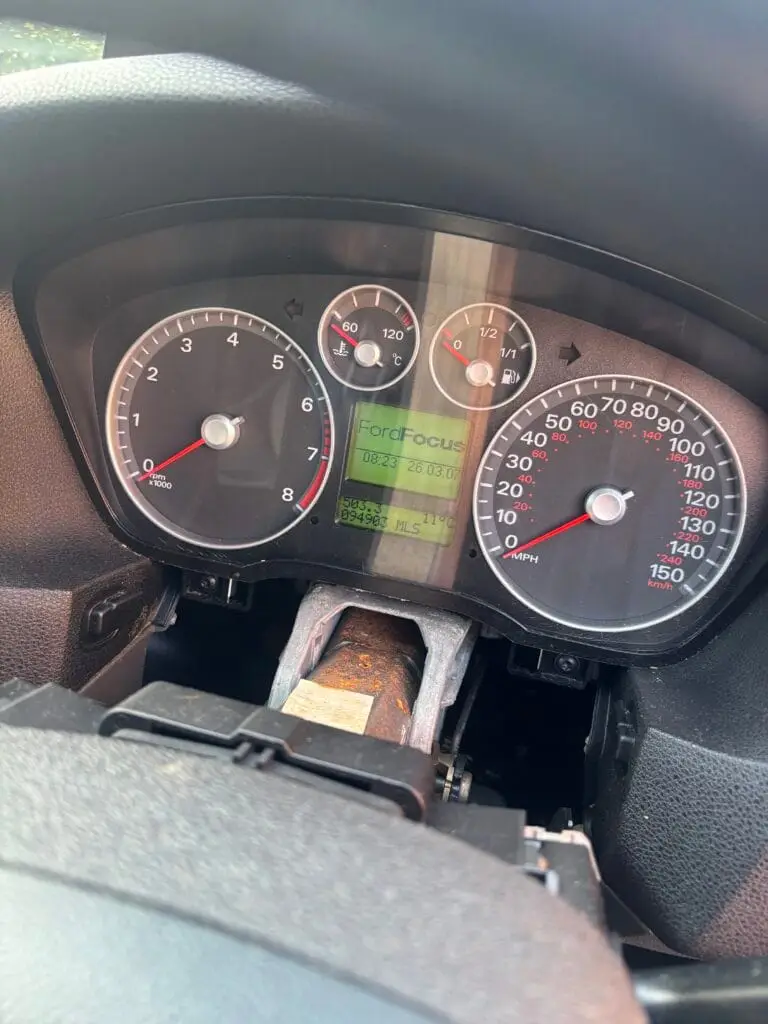

Many drivers become concerned when their car won’t start, often leading to the discovery of these electrical problems.
Older Ford vehicles — particularly from the late 1990s to mid-2000s — are known to suffer from dry (cold) solder joints in their dashboard clocks and instrument clusters. This is a common fault that can cause various electrical issues, especially in older models which have seen significant usage over the years. Over time, these solder joints can crack and lead to intermittent electrical connections. Drivers often find themselves frustrated with these issues as they can manifest in numerous ways, affecting not just the dashboard functionality but also impacting vehicle performance. For instance, when your dashboard clock fails, it can lead to the entire instrument cluster malfunctioning, which is critical for monitoring speed, fuel levels, and engine temperature.
It’s important to note that if your car won’t start, electrical issues like these can be a primary cause, especially in older models.
When drivers notice their car won’t start, they should first consider the potential impact of these dry solder joints.
Expanding on the implications of dry solder joints, it is essential to acknowledge that these electrical issues can affect not only the dashboard but also the essential electronic systems that power your vehicle. For instance, when these joints fail, it can disrupt the communication between the engine control unit (ECU) and other critical components, potentially leading to performance issues like stalling. Additionally, consider how modern driving relies heavily on electronic interfaces, making any malfunction a serious concern for safety and usability.
⚠️ More Symptoms to Watch For: Beyond the initial signs of dry solder joints, certain behaviors of your vehicle can indicate deeper electrical issues. For instance, you may notice that your car’s headlights flicker or dim when the ignition is engaged, which can suggest power distribution problems stemming from the instrument cluster. Furthermore, abnormal noises during startup or operation can also signify underlying electrical malfunctions.
For many, the realization that their car won’t start can be traced back to these electrical faults.
If a driver experiences a situation where their car won’t start, it could be due to a failure in these systems.
Why Your Older Ford’s Electrical Issues May Cause Your Car Won’t Start
This lack of response can lead to situations where your car won’t start, highlighting the importance of immediate attention.
When diagnosing issues with your vehicle, it’s crucial to understand that if your car won’t start, it could be linked to these electrical problems.
Drivers should also be aware that the lack of response from electronic systems can create a cascading effect. For example, if the ignition system fails to communicate with the ECU, it may lead to unexpected engine behavior, potentially causing safety risks on the road. This aspect emphasizes the importance of addressing dashboard and electrical issues promptly to maintain vehicle reliability.
⚠️ Common Symptoms of Dry Solder Joints in Ford Clocks:
In addition to the symptoms listed, drivers may experience a lack of response from the car’s various electronic systems, which can lead to confusion and even unsafe driving conditions. Electrical issues may prevent the car from starting, exemplifying how a simple problem with the dashboard can escalate into more significant vehicle malfunctions.
- Clocks display flickers, disappears, or resets intermittently.
- Car won’t start at all or resets after turning off the ignition.
- Display completely dead, then comes back randomly.
- Tapping the dashboard causes the clocks to work again temporarily.
- In some models, other dashboard electronics (radio, backlight, etc.) may also act up.
✅ Affected Ford Models (Common Cases): Various Ford models are known to exhibit these problems, which can be traced back to the manufacturer’s design choices during that era. Understanding which models are most affected can help owners take preventive measures or seek timely repairs.
- Ford Focus Mk1 (1998–2004) – especially the LCD clock above the radio.
- Ford Mondeo Mk3 (2000–2007)
- Ford Fiesta (early 2000s)
- Some Ford Transit models and KA may also suffer similar issues.
🔧 DIY Fix: Reflow or Re-solder the Joints – If you’re comfortable with electronics, there’s potential for a DIY fix which can save time and money. Many enthusiasts have successfully resolved these issues through careful repair, restoring functionality to their vehicles without the need for costly replacements.
✅ Extended List of Affected Models: While earlier models are primarily affected, it’s important to remember that other vehicles from the same era may exhibit similar problems. Models like the Ford Explorer and the Ford Expedition, produced in the late 90s and early 2000s, can also show signs of electrical problems associated with their instrument clusters. Owners of these vehicles should remain vigilant about monitoring any similar symptoms that arise.
If you’re comfortable with electronics, follow these steps carefully to restore your dashboard systems:
- Remove the clock unit from the dashboard (usually held in with clips or screws).
- Open the casing and locate the circuit board.
- Look for dull, cracked, or circular (ring-shaped) solder joints — especially where the display or power connections are soldered.
- Reflow the solder using a soldering iron and a bit of fresh solder (lead-based works better for this fix).
- Inspect under magnification if needed.
- Reassemble and test.
When diagnosing why your car won’t start, the condition of the solder joints may be a significant factor.
Monitoring signs that your car won’t start can help prevent more serious issues down the line.
If your troubleshooting leads you to find that your car won’t start, consider checking the solder joints.
Tip: Focus especially on the power supply pins and any large pins that bear mechanical stress, as these are common failure points that can lead to electrical issues in the future.
🧰 Not Confident? Consider These Options: If the DIY approach feels daunting, there are several other avenues to explore that may help resolve these frustrating issues effectively.
- Some Auto locksmiths will fix this problem.
- Replacement used units from scrapyards are available, but may suffer the same issue eventually.
🔧 Additional Repair Insights: If you decide to take on the repair yourself, remember that patience and precision are key to successful soldering. As you work, keep in mind that using a multi-meter to test connections before and after your repair can help ensure that the electrical pathways are functioning correctly. This proactive step can save you time and frustration in the long run.
Don’t hesitate to consult online forums and communities composed of fellow Ford enthusiasts. Sharing experiences and tips can provide valuable insights into the specific quirks of your model, and may even uncover innovative fixes that have worked for others facing the same issue.
Identifying why your car won’t start may involve examining both the electrical systems and the dashboard.
For long-term solutions, consider investing in a new dashboard unit if electrical issues persist, as this can provide reliability and restore your vehicle’s functionality, ensuring that your car won’t start problems are a thing of the past.
🧰 Professional Assistance: For those who may not feel comfortable attempting a DIY repair, it is advisable to seek professional help. Auto electricians with experience in older Ford models can diagnose and remedy electrical problems effectively. When selecting a mechanic, look for reviews and ask for recommendations to ensure you find someone who is knowledgeable about these specific issues.
Understanding the symptoms that indicate your car won’t start can be essential for any Ford owner.
Beyond the immediate fixes, consider the long-term maintenance of your vehicle. Establishing a regular check-up schedule for your car’s electrical systems can help catch issues before they escalate. This preventative approach not only prolongs the life of your vehicle but also enhances your driving safety and comfort.
Ultimately, understanding the relationship between your vehicle’s electrical components and their impact on functionality is crucial. A car that won’t start is often a symptom of larger electrical dilemmas. By staying informed and proactive, you can mitigate these risks and keep your Ford running smoothly.
Taking preventive measures ensures that your car won’t start issues are not frequently encountered.
Understanding that a car that won’t start often signals deeper issues can help drivers take timely action.
By keeping watch for symptoms that signal your car won’t start, you can avoid being stranded.
